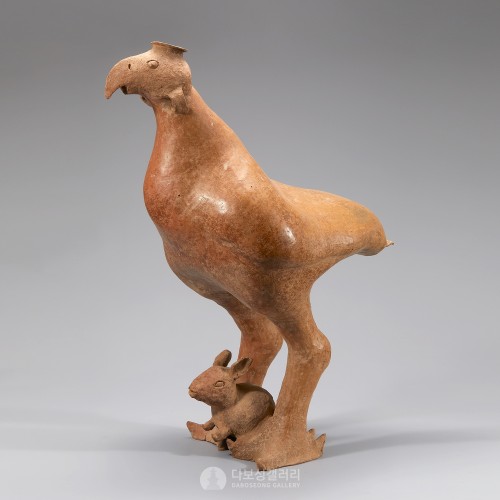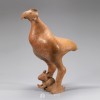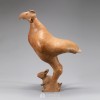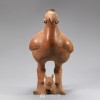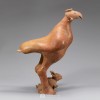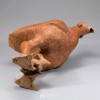본문
이 유물은 매가 토끼를 사냥하는 장면을 표현한 홍도(红陶)입니다. 부리가 매서운 매의 머리 위에 동그란 구멍이 뚫려 있어 물이나 술을 담아 보관하는 용도로 사용되었음을 알 수 있습니다. 매의 두 다리 사이에는 토끼가 겁을 먹은 듯한 표정으로 붙잡혀 있습니다.
중국에서 흙으로 그릇을 만드는 토기 문화는 신석기시대에 시작되어 도기 문화로 발전했습니다. 신석기시대의 중국 도기는 황하(黄河) 유역과 장강(長江) 유역·동남해안·북방 유역 등으로 광범위하게 분포합니다. 황하와 장강 중상류 지역은 채도로 유명하고, 하류 지역은 정교한 백도기(白陶器)와 흑도기(黑陶器)로 유명하며, 동남해안 지역은 경도기(硬陶器)로 대표되고, 북방 지역은 특색 있는 조형도기로 유명합니다. 신석기 도기는 제작 방법에 따라 수제(手製)·모제(模製)·완륜(慢輪)·쾌륜(快輪)으로 나뉘며, 문양으로는 압인(壓印)·박인(拍印)·각화(刻畵)·채색(彩繪)·누공(鏤孔)으로 나뉩니다. 제작 가마로는 횡혈요·수혈요가 있습니다. 이처럼 다양한 신석기시대의 다양한 도기문화는 오늘날 도자기의 모태가 되었습니다.
这是描述鹰抓兔子场面的红陶器。尖嘴鹰的头上有一圆形的口用来盛并储存水或酒。鹰的两条腿之间的兔子似露出害怕的表情。
在中国,土制陶器的陶器文化始于新石器时代,并发展为陶器文化。新石器时代的中国陶器广泛分布在黄河流域、长江流域、东南沿海、北方流域等。 黄河、长江中上游地区以彩陶著称,下游地区以精美的白陶、黑陶著称,东南沿海地区以轻陶为代表,北方地区以特色造型陶器著称。新石器陶器根据制作方法分为手工、毛制、完轮、快轮,图案分为压印、剥印、刻画、彩绘、镂空。制作窑炉有横穴窑和输血窑。如此多样的新石器时代的各种陶器文化成为了当今陶瓷的雏形。
A red pottery vessel of a falcon hunting a rabbit. A mouth is on the head of the fierce-looking falcon figurine, indicating that it was used as a drink or water vessel. Between the two legs is a small frightened rabbit captured.
Chinse pottery began in the Neolithic period and developed into earthenware. Neolithic Chinese earthenware is widely distributed along the Yellow River, the Yangtze River, the southeast coast, and the northern basin. The upper-middle areas of the Yellow River and Yangtze River are known for painted pottery, the downstream area is known for elaborate white pottery and black pottery, the southeast coastal area is represented by hard pottery, and the northern region is famous for its distinctive shaped pottery. It is also divided into the hand-made, mold-made, slow wheel, and the fast wheel by production method. The patterns are divided into stamped, printed, engraved, painted, and perforated. Kiln types include horizontal kilns and vertical kilns. As such, various pottery cultures of the Neolithic Age became the beginning of pottery today.
